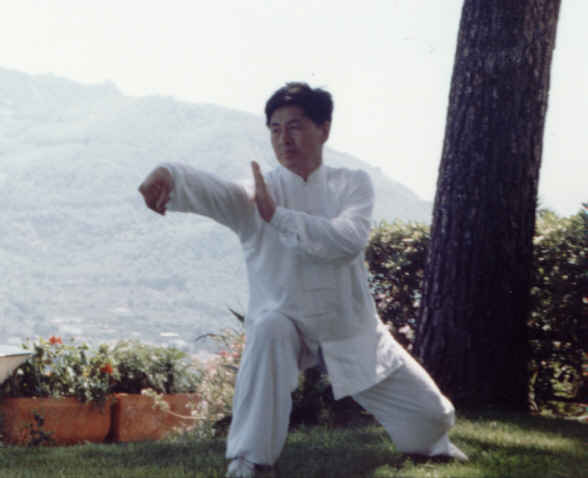|
|
|
 |

QIXING TANGLANG QUAN GRANDMASTER
ZHONG LIANBAO
Zhong Lianbao shifu of
Yantai, Shandong was very fond of Wushu in his youth, in 1953 he began to
trained under grandmaster Lin Jing Shan in the art of Qixing Tanglang Quan.
Under the strict tutelage of grandmaster Lin, and hard and rigorous training,
Zhong shifu was able to learn the comprehensive knowledge and techniques of
Qixing Tanglang Quan. Zhong shifu has joined several national and provincial
Wushu competitions, where he garnered several Exemplary awards for his skills.
He also was invited to judge in several prestigious competitions, and have also
been appointed as head judge in some of the competition. At present Zhong shifu
continued to propagate the art of Qixing Tanglang Quan and carry on the task in
preserving this priceless traditional art as passed on to him by grandmaster Lin
Jing Shan.
COMPETITIVE YEARS
In 1959 Zhong Lianboa shifu
joined the Shandong Wushu Competition, during this time Traditional Tanglang
Quan were not included, only contemporary Chang Quan (Long Fist) was part of the
competition. From 1959 up
to 1972 Zhong shifu represented Yantai in the many Shandong Wushu Competition.
It was during those period that Zhong shifu began to discuss with Wushu friends
the art of Wushu, in furthering understanding the essence and truth behind
Wushu. In the 10th Shandong Athletic Meet Wushu Competition, Zhong shifu was
appointed as assistant chief judge.
In 1977 the National
Athletic Commission began to promote Traditional Wushu.
PROPAGATION OF QIXING
TANGLANG
Zhong Lianbao shifu being a
legitimate Qixing Tanglang master, he took up the cudgel of promoting the art.
As early as 1980 during the 2nd National Traditional Wushu Competition he was
able to meet with Qixing Tanglang counterpart from Hong Kong, which lead to the
understanding of Qixing Tanglang development outside China. That same year he
was in Guangzhou where he took the opportunity to established contact with local
Wushu Association assistant chairman Guo Zishi, who was a former student of Luo
Guangyu. Assistant chairman Guo asked Zhong shifu to teach his student some of
Qixing Tanglang Quan form, which Zhong shifu obliged. In 1982 assistant chairman
Guo sent 3 of his students to Yantai to further study with Zhong shifu. On that
same year Jinan Qixing Tanglang enthusiast came to Yantai to be instructed by
Zhong shifu. In 1984 Zhong shifu sent his two nephew Zhong Qiyong and Zhong
Zhiping to compete in the Qingdao Traditional Wushu Competition where they
garnered Excellent Awards for their outstanding performances. In 1954 two of
Chen Zhenyi's disciple came to Yantai and study Qixing Tanglang with Zhong shifu.
Even Shenyang Qixing Tanglang Organization have benefited by Zhong shifu
selfless teaching.
PROMOTING THE ART ABROAD
In 1993 the Philippine Ling
Nam Athletic Association sent a Wushu team to compete in the International
Tanglang Quan Exhibition Competition, during the said competition Ling Nam
members met with Zhong shifu students, and eventually meeting Zhong shifu. Ling
Nam members asked Zhong shifu to accept them as his disciples, with their
insistence and sincerity, they later became
Zhong shifu first batch of overseas disciples. Zhong shifu was invited several
times to visit the Philippines. During each visit he continued to teach Qixing
Tanglang.
In
1996 he accepted an invitation to attend the Asian Wushu Championship held in
the Philippines, during that period he taught Qixing Tanglang Quan in Manila and
Baguio City.
Upon the
invitation of Italian Olympic Committee, Zhong Lianbao shifu traveled twice to
Italy to teach Tanglang Quan, at the same established the Intwernational Qixing Tang Quan
Association. That same year, Zhong shifu performed at the Singapore Second
National Wushu Exhibition upon the invitation of the Singapore National Wushu
Association.
In
1998 Zhong shifu was invited to perform at the “World of Wushu” show
organized by Ling Nam Athletic Association in celebration of its 40th
founding anniversary. He received high praise for his superb performance, during
that period he accepted a Taiwanese disciple. Later that year he was invited to
Germany, Belgium and Italy to conduct Qixing Tanglang seminar, this lead to the
propagation of Qixing Tanglang in Europe.